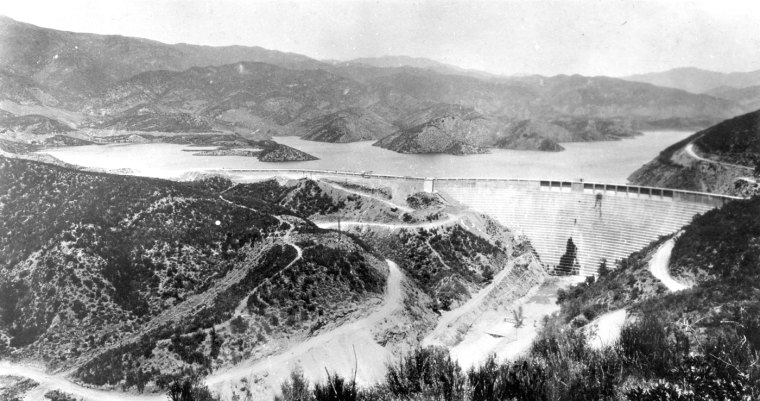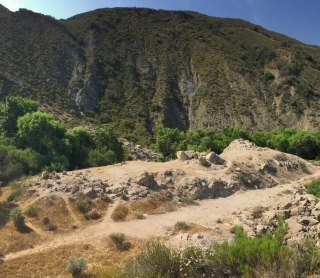For the nearly 18 million residents of the greater Los Angeles metro area, Angeles National Forest is a stunning backyard. Spanning 700,000 acres, the forest flanks the city to the north and east and includes the San Gabriel Mountains and the San Francisquito Canyon watershed, home to many historical, cultural, and ecologically significant sites.
In addition to being a popular area for recreation, Angeles National Forest is also a unique ecosystem that supports threatened and endangered wildlife. Increased fire activity throughout Southern California is jeopardizing these unique landscapes. This fire activity has long-term, lasting effects on the ecosystem. Decreased vegetation reduces soil stabilization, resulting in increased erosion rates; sedimentation runoff into local watersheds clogs culverts, inhibits fish passage, and degrades water quality.
A few significant fires in the early 2000s, including the Copper Fire of 2002, denuded the vegetation within the San Francisquito Canyon watershed, significantly altering the landscape. In addition to the obvious impacts to upland habitats, the fire also severely impacted aquatic habitat in the watershed. This watershed is subject to high levels of sedimentation in its natural state, but after the Copper Fire, excessive amounts of sediment were eroded into San Francisquito Canyon Creek, damaging aquatic habitat and water quality throughout.
Restoring the watershed following the fire was a top priority, but not without significant challenges. It would require a vast network of experts across a variety of public and private organizations working together, balancing the needs of the forest and organisms with those of the various stakeholders. In 2016, Angeles National Forest partnered with the National Fish and Wildlife Foundation (NFWF) to restore the watersheds and ecosystems directly impacted by the Copper (2002), Ranch (2007), and Sayre (2008) fires. Through the Angeles National Forest—Wildfires Restoration Grant Program various organizations were awarded grants to work on different aspects of watershed restoration. SWCA was honored to join the effort in partnership with Resource Institute, Inc. and Southwest Aquatic and Terrestrial Biology (SWAT), as part of a multi-phased project titled the San Francisquito Canyon Aquatic Barriers Restoration Program.
Aquatic Organism Passages
Through this public-private partnership, the project partners are planning river restoration at three distinct sites along San Francisquito Canyon creek in the Angeles National Forest. The goal of the project is to restore Aquatic Organism Passage (AOP) – primarily for the California red-legged frog (CRLF; Rana draytonii) and unarmored threespine stickleback (UTS; Gasterosteus aculeatus williamsoni), both federal and state listed species – at five high priority barriers along the creek. An AOP barrier is an obstruction within a stream channel that prevents aquatic organisms from moving upstream and can limit the habitat to which they have access.
Phase 1 of the project involves developing permitting documents (including NEPA), stakeholder and community outreach, biological and cultural resource support, and engineered natural channel designs. Each of the three restoration project sites contain one or more Aquatic Organism Passage (AOP) barriers. The three sites in this project are as follows (listed from upstream to downstream):
- Powerhouse 1 (PH1) Site: There are three degraded road crossing culverts on Forest Service roads near Los Angeles Department of Water and Power’s (LADWP’s) Powerhouse 1 facility*. These culverts have been filled in with sediment or crushed and are no longer functioning as intended. As a result, aquatic organisms are unable to swim upstream past these culverts.
- Saint Francis Dam (SFD) Site: This is the historic site where the Saint Francis Dam previously stood, until its disastrous collapse in 1928 (see below). Remnants of the dam within the creek are causing an AOP barrier at this location.
- Powerhouse 2 (PH2) Site: This is an in-stream concrete overflow structure for LADWP’s Powerhouse 2 facility. The entire streambed has been paved here, and there is significant erosion occurring at the downstream end of the structure. The resulting drop in stream elevation poses an AOP barrier at this location.
While all of these sites have been impacted by wildfires, the project partners are taking a holistic approach with the aim of addressing all resource issues affecting each site. At the PH1 site, the new culverts will be designed to handle increased sediment loads in the future, providing ecological resiliency for the watershed and securing safe access for Forest Service and LADWP staff that rely on the roads. Similarly, restoration at the SFD site will address excessive sedimentation from the Copper fire, but will also consider solutions to further protect the site for its historical and cultural value. The PH2 site will support recovery of fire-impacted species and habitats, but also must consider operational needs of LADWP’s facilities, which are crucial for LA’s water supply infrastructure.
*Please note that this project is on USFS land, not LADWP owned lands.
 St. Francis Dam before it failed. Courtesy: USGS
St. Francis Dam before it failed. Courtesy: USGSThe St. Francis Dam: A Unique Challenge
Even if you’re not familiar with San Francisquito Canyon watershed, you may have heard of the St. Francis Dam disaster of 1928, one of the largest engineering failures in U.S. history. The St. Francis Dam was a curved concrete gravity dam, built to create a large reservoir to provide water to the city of Los Angeles. On March 12, 1928, just two years after construction was completed, the dam failed catastrophically, sending a wall of water down canyon and claiming the lives of more than 430 people. The collapse was later deemed to be inevitable, because the dam was built on an unsuitable foundation.
Today, the SFD site serves as an informal memorial for the lives lost in the dam disaster, and visitors come regularly to pay their respects. Remnants of the dam have been left behind in San Francisquito Canyon Creek, which provides sensitive cultural and historical context to visitors. However, those remnants are also contributing to an AOP barrier.
Downstream of the barrier, the creek supports the UTS, a small freshwater fish that is a state and federally listed endangered species and a State of California Fully Protected Species. The AOP barrier is blocking the UTS from accessing upstream habitat. This portion of the watershed also supports the federally threatened CRLF; sedimentation from the wildfires in conjunction with changing climate, and human activity in the area, has impacted and even destroyed much of the suitable habitat that previously existed in the watershed for this species. Due to the Fully Protected Species status of the UTS, which under most circumstances does not allow for any incidental impacts to the species, the approach to permitting the project must be considered very carefully. The project team is working closely with resource agencies to gain the necessary approvals and ensure the project protects and aids recovery of this important species.
Simply put, the straightforward solution of removing all the rubble left behind by the dam is not an option, because:
- Instream work at the site must be minimized in light of the Fully Protected Species status of the UTS that are known to exist there;
- the dam site is a significant historical resource;
- the community that views/uses the SFD site as a memorial do not want the dam remnants to be removed entirely, and the significance of the site from an historic preservation perspective would also make that infeasible;
- the remnants of the dam that are posing an AOP barrier have also created an instream pond that is providing high-quality habitat for the CRLF.
Our Partnership & Program Goals and Objectives
Resource Institute, SWCA, and SWAT are tasked with designing a restoration project that:
- Improves AOP to acceptable levels at all three project sites;
- Protects existing instream pond habitat that was created by the barrier at the SFD site;
- Preserves significant cultural resources at the dam site;
- Allows an acceptable amount of access to the dam site for interpretation and memorialization, while limiting access that deteriorates the condition of the site further and renders it susceptible to vandalism;
- Meets LADWP’s needs for access to and maintenance of the PH1 and PH2 sites.
The project partners are working together along with the Angeles National Forest and NFWF to address the complex resource issues in this fire-affected watershed. With guidance from Resource Institute, SWCA and SWAT have mobilized field teams to conduct a geomorphic assessment and biological resource surveys.
Resource Institute’s partnership with SWCA and SWAT on this project will establish a model for future restoration efforts throughout the region where similar issues of species passage and protection must be addressed for successful project implementation. Professional staffs of each organization are highly trained and well prepared to integrate the multiple strategies needed to effectively collaborate with federal, state, local and private stakeholders to successfully accomplish this project.” - Squeak Smith, Chairman of Resource Institute.
The entire project team is collaborating on the best approach to restoration designs, public engagement, and environmental review. Currently, UTS experts at SWAT are engaged in scientific research within the watershed, including assessment of the health of the UTS subpopulation and physical habitat in the San Francisquito Canyon Creek relative to other remaining native subpopulations in the Santa Clara River watershed. By supporting and incorporating SWAT’s research into the project, we hope to secure an MOU that would allow UTS restoration at these important sites. In the coming months, we will conduct cultural resource surveys, evaluate design alternatives, and begin preparing permits and other environmental documents.
We are also in the process of forming a Community Watershed Council (CWC) to get more public involvement with the project, and a Technical Advisory Committee (TAC) of agency personnel to ensure the resulting project will have agency support. Part of the CWC will also include volunteer events at the project site. Volunteer work is an important part of the project; it provides hands on teamwork with the community, garners support for the project, and allows for early restoration to occur at the site.
The Road to Recovery
While it will likely take years before restoration at these sites is realized, we’re proud of the collaboration that has already occurred amongst all of the project partners. Resource Institute’s ability to develop funding streams for restoration projects and their national perspective on the most cutting edge restoration techniques are the perfect complement to the technical expertise and local knowledge brought to the table by SWCA and SWAT. The Angeles National Forest and NFWF have supported these restoration efforts with a true spirit of collaboration and commitment to excellence. The partnerships being forged through this and other grant-funded projects in the Angeles National Forest are a great example of what can be accomplished when everyone works together with a singular goal of protecting and restoring our public lands.
